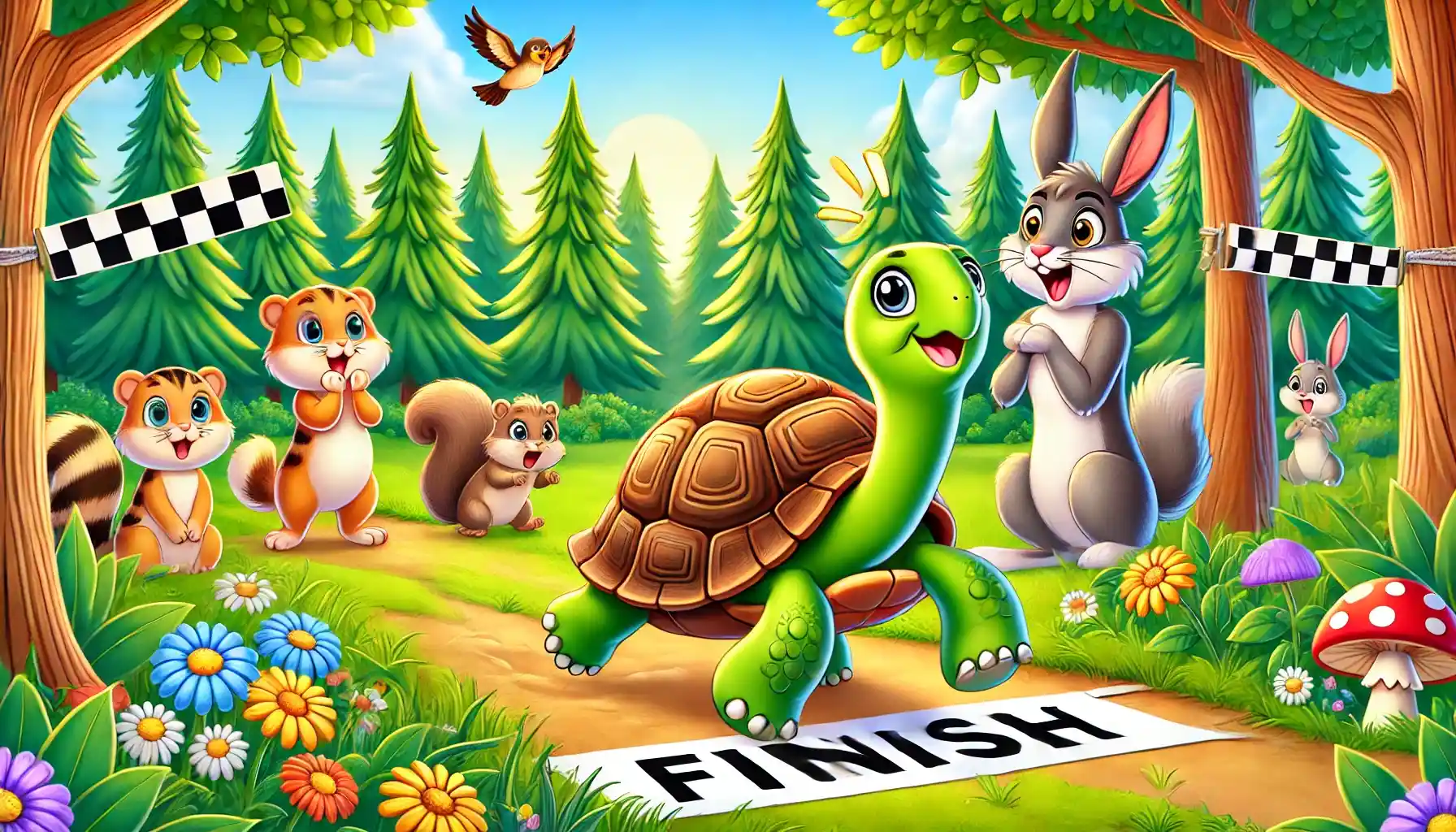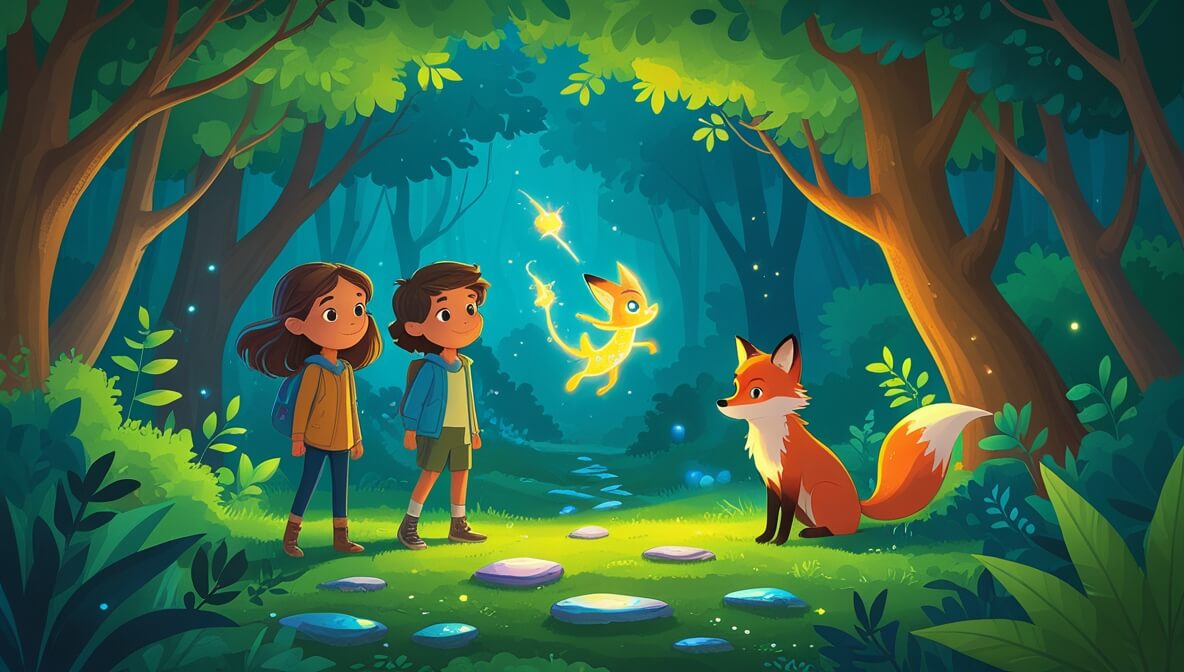A slow and steady tortoise challenges an overconfident hare to a race. This story shows how determination can triumph over arrogance.
Age Recommendation
3 - 10 years
Characters of The Tortoise and the Hare
Characters:
- Tortoise (a patient and determined tortoise)
- Hare (a fast but overly confident hare)
- Forest Friends (animals who cheer and watch the race)
Story of The Tortoise and the Hare
Once upon a time in a lush green forest, there lived a speedy hare and a slow-moving tortoise. The hare was proud of his speed and often mocked the tortoise for being so slow.
One day, tired of the hare's teasing, the tortoise challenged him to a race. The hare laughed at the idea, confident that he would win easily. "You're on!" he said, and they set a date for the race.
On the day of the race, all the animals gathered to watch. The race began, and the hare dashed ahead, quickly leaving the tortoise far behind. Feeling secure in his lead, the hare decided to take a nap under a shady tree.
Meanwhile, the tortoise kept moving slowly but steadily. He passed the sleeping hare and continued on his way. The other animals cheered him on, but the hare remained blissfully unaware of what was happening.
After a while, the hare woke up and, seeing that the tortoise was nowhere in sight, laughed and thought he had plenty of time to catch up. He sprinted towards the finish line, but to his shock, he saw the tortoise crossing it just as he arrived.
The tortoise had won the race!
Tortoise smiled and said, "You may be fast, but I never gave up. Slow and steady wins the race." Hare nodded, realizing his mistake. From that day on, he learned to never underestimate anyone and to always stay humble.
The end.
Moral of the The Tortoise and the Hare Story
Patience and determination can achieve great things, even when the odds seem against you. Overconfidence and underestimating others can lead to failure. Always stay focused, work hard, and respect others, no matter how different they may seem.
Do You Know
- Some tortoises can live for over 100 years, making them one of the longest-living animals on Earth!
- Hares are faster than most animals and can run up to 45 miles per hour in short bursts.
Word Explorer
- Determination: The act of not giving up, even when things are tough.
- Overconfidence: Being too sure of yourself and underestimating challenges.
- Steady: Moving at a constant pace, without rushing or stopping.
Emotions in the Story
- Excitement: When the race begins and the animals cheer.
- Confidence: Harvey’s belief that he would easily win.
- Triumph: Tommy’s joy when he crosses the finish line first.
Color the scene of The Tortoise and the Hare story
Imagine the race scene with the Tortoise slowly walking toward the finish line while the Hare wakes up in the background. What colors would you use for tortoise shell, the forest trees, and the cheering animals? Draw the moment when the tortoise wins the race, surrounded by his happy forest friends!
Parents' Corner
Discuss with your child the importance of patience and perseverance, as shown by the Tortoise. Ask them about a time when they worked hard and didn’t give up, even if things seemed difficult. Talk about the value of respecting others and not judging someone’s abilities too quickly. Use this story as a way to encourage your child to stay focused on their goals, no matter how big or small.
Frequently asked questions about The Hare And The Tortoise Story.
What is the moral of the story The Tortoise and the Hare?
The hare, overly sure of its victory, takes a break during the race and falls asleep. Meanwhile, the tortoise keeps moving forward at a slow, steady pace without stopping and ultimately wins. The story teaches that steady and consistent effort often leads to greater success than rushing carelessly.
What is the meaning of The Tortoise and the Hare story?
The phrase “Slow and steady wins the race” captures the central theme of Aesop’s fable. In this picture book, detailed and vibrant illustrations bring the story to life. They show the hare confidently challenging the tortoise, the tortoise’s slow but determined journey, and his ultimate victory as the hare gets distracted. The imagery beautifully conveys the fable’s message without relying heavily on words. It reminds readers that persistence and patience often triumph over haste and overconfidence.
What is the hare and the tortoise myth?
Fed up with the hare’s constant bragging, the tortoise proposes a race. The hare bursts ahead at the start, but feeling sure of victory, he stops midway for a nap. To his surprise, when he wakes up, the tortoise, moving slowly and steadily, has already crossed the finish line and won.
Why does the Tortoise beat the hare?
Fed up with the hare’s constant bragging, the tortoise proposes a race. The hare bursts ahead at the start, but feeling sure of victory, he stops midway for a nap. To his surprise, when he wakes up, the tortoise, moving slowly and steadily, has already crossed the finish line and won.
What do children learn from the moral of The Hare and The Tortoise’ Story?
Stay calm in life. Children can learn from the tortoise, who remained composed and undisturbed by the hare’s constant teasing. His confidence and peaceful attitude allowed him to persevere.
Avoid being overconfident. The hare’s belief in his certain victory led to carelessness, costing him the race.
Stay focused on your goals. The story teaches children the importance of keeping their eyes on their goals and avoiding distractions. This mindset is key to achieving success.
Who wrote the Hare and the Tortoise story?
Centuries ago, Aesop created a series of stories known as Aesop’s Fables. These short tales use animals in human-like roles to convey meaningful life lessons or morals, often aimed at children. Among his many works, one of the most well-known is The Tortoise and the Hare, a timeless story that continues to teach the value of persistence and humility.
When was The Tortoise and the Hare first written?
The fable exists in Greek but lacked an early Latin version, which delayed its inclusion in printed collections of Aesop’s fables until the 16th century. One of the earliest printed versions was Bernard Salomon’s Les Fables d’Esope Phrygien, mises en Ryme Francoise in 1547.
Origin And History of The Story Of The Hare and Tortoise Story
This classic bedtime tale traces back to Aesop’s Fables, delivering a powerful lesson about uplifting others rather than putting them down. It teaches the importance of humility, avoiding boastfulness, and inspiring those around us. While the story has evolved through countless variations over the years, its essential message and key elements have stayed true.Author of the story of The Hare and Tortoise Story
The story of The Hare and the Tortoise is attributed to Aesop, a storyteller and fabulist believed to have lived in ancient Greece around the 6th century BCE. Aesop is famous for his fables—short stories that convey moral lessons, often featuring animals with human-like traits.
Who Was Aesop?
While much about Aesop's life remains unclear and surrounded by legend, he is thought to have been a slave who earned his freedom due to his wit and storytelling abilities. Many accounts suggest that he was an exceptionally clever and observant individual who used his tales to impart wisdom and comment on human behavior.
Aesop's Fables
The collection of stories attributed to Aesop includes hundreds of fables, such as The Boy Who Cried Wolf, The Fox and the Grapes, and The Lion and the Mouse. Each fable typically concludes with a moral, making them popular teaching tools for both children and adults throughout history.
Legacy
Though Aesop likely did not write down his stories, they have been passed down through oral tradition and later compiled by authors and translators. His works have been translated into numerous languages and remain a cornerstone of literature, valued for their timeless lessons about life, character, and ethics.











